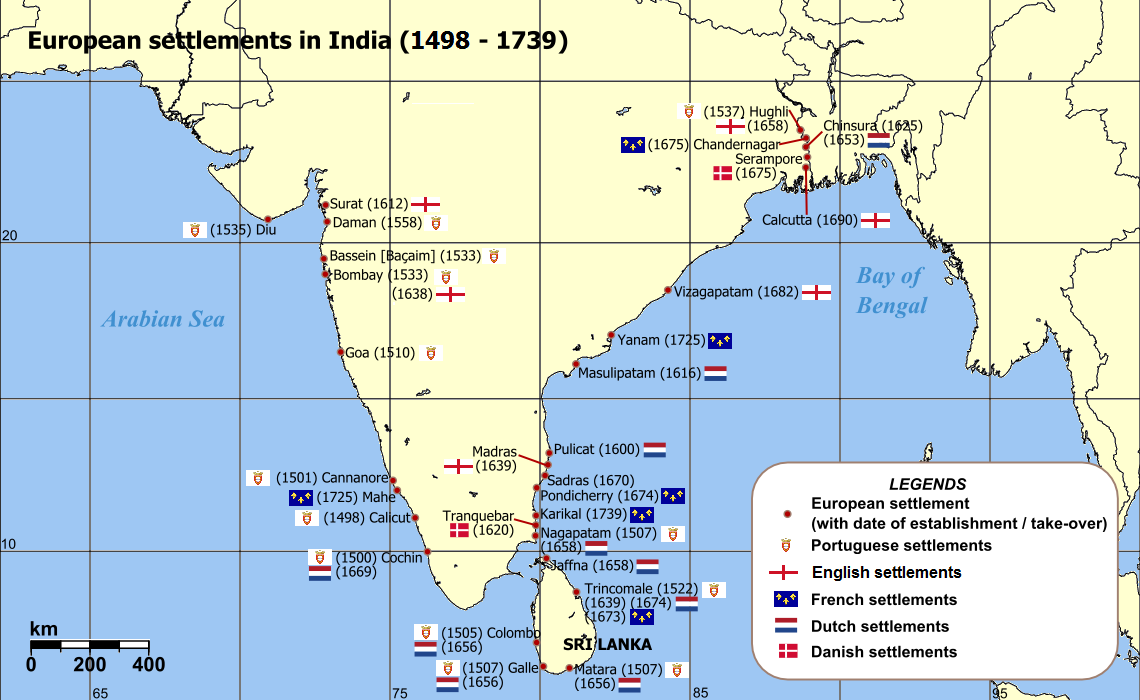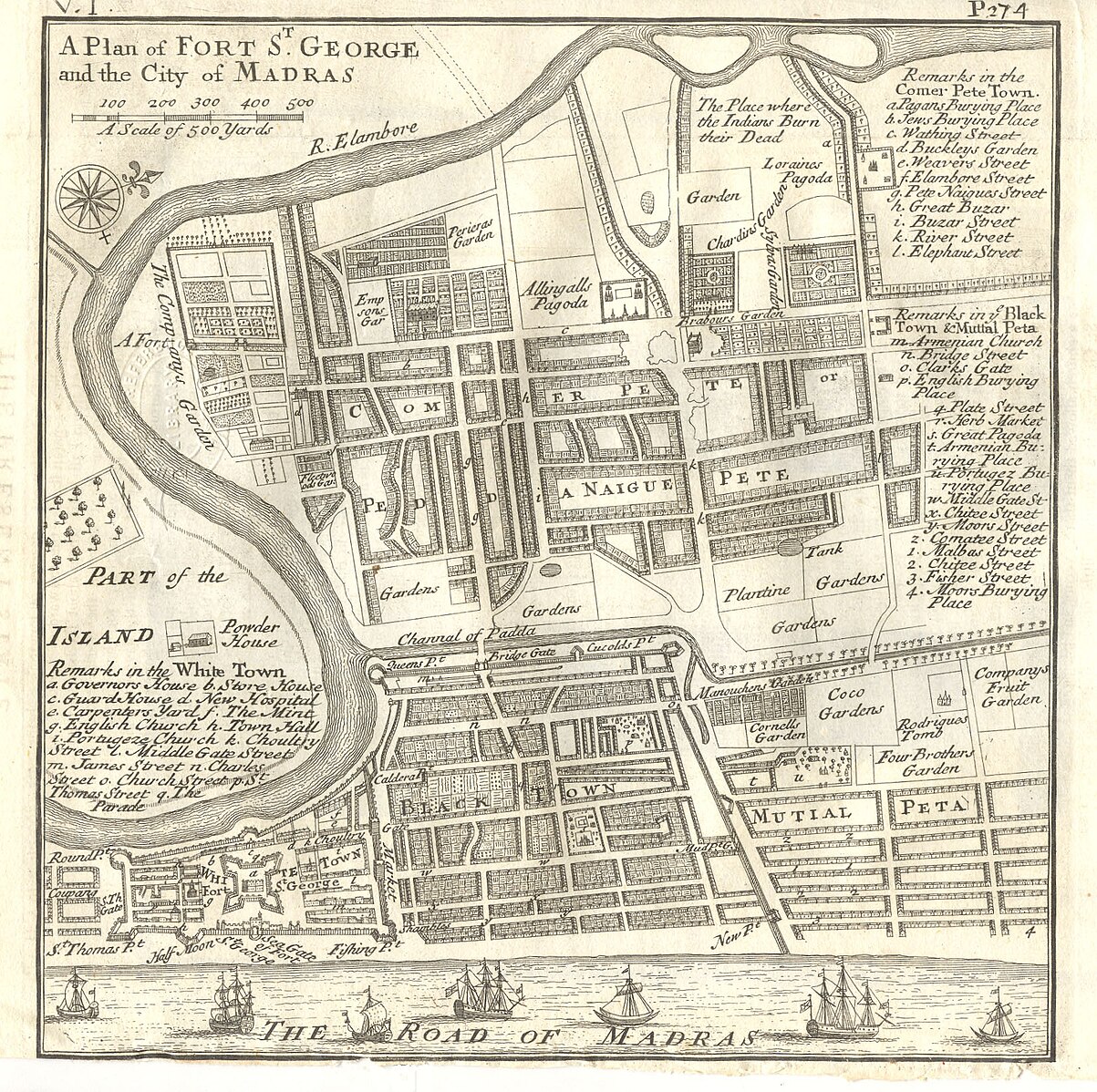OCR Specification focus:
‘The coming of and Mughal relations with the British; the struggle for the succession and civil wars 1657–1658 between Shah Jahan’s sons’
The mid-seventeenth century was pivotal for the Mughal Empire, witnessing both the arrival of European trading powers and a bitter civil war among Shah Jahan’s sons.
The Arrival of the British
Early European Influence
By the early seventeenth century, European powers—notably the Portuguese, Dutch, French, and British—were increasingly active in Indian waters and coastal trading centres. The English East India Company (EIC), chartered in 1600, sought a foothold in the lucrative spice and textile markets of South Asia.

Map of European settlements in India (1501–1739), highlighting English factories at Surat, Madras (Fort St George), and Bombay under Mughal suzerainty. It clarifies that early European presence was concentrated in port cities rather than the interior. Source
Establishment of British Presence
The Mughal Emperor Jahangir had granted the EIC limited trading rights in the early 1600s, but it was under Shah Jahan that British presence became more formalised. By the 1630s, the British had:
Established factories (trading posts) at Surat, Madras, and later Bombay.
Negotiated for firmans (royal decrees) from the Mughal court, granting permission to trade.
Developed maritime power to protect their trade from rivals.

Plan of Fort St George and the city of Madras (1726), showing the fortified EIC enclave, harbour approaches, and adjacent urban quarters. It exemplifies the factory/fort model through which the British operated under the Mughals. The date (1726) is slightly later than Shah Jahan, but the layout remains representative of the period’s institutional footprint. Source
Mughal-British Relations under Shah Jahan
Shah Jahan generally maintained a pragmatic policy. His court:
Permitted commercial privileges in exchange for customs duties and respect for Mughal authority.
Carefully balanced relations with multiple European traders, ensuring no one power gained dominance.
Used Europeans as military allies and weapons suppliers, though their influence within the empire remained limited.
The British role was still marginal compared to Mughal political power, but their foothold laid foundations for later expansion.
The Succession Crisis of 1657–1658
Background
By the mid-1650s, Shah Jahan was ageing, and his extensive building projects—such as the Taj Mahal and Red Fort—had strained imperial finances. His illness in 1657 triggered a struggle for succession among his four surviving sons:
Dara Shikoh – Shah Jahan’s eldest and favoured heir, known for his interest in Sufi mysticism and Hindu-Muslim syncretism.
Aurangzeb – A devoutly orthodox Muslim, militarily capable, and ambitious.
Shuja – Governor of Bengal, with substantial regional power.
Murad – Governor of Gujarat, allied with Aurangzeb.
Nature of Mughal Succession
Mughal Succession: The transfer of imperial power was not based on primogeniture (automatic inheritance by the eldest son) but through open contest, often involving military struggle.
This system meant civil wars were common, with princes building alliances among nobles and regional elites.
The Civil Wars
The conflict unfolded in several stages:
Initial Alliances
Dara Shikoh relied on Shah Jahan’s backing and imperial resources.
Aurangzeb allied with Murad to strengthen his military position.
Shuja pursued his claim independently from Bengal.
Key Battles
Battle of Bahadurpur (1658): Shuja was defeated by Dara’s forces.
Battle of Dharmat (April 1658): Dara’s army was decisively beaten by Aurangzeb and Murad, weakening his legitimacy.
Battle of Samugarh (May 1658): The pivotal clash where Aurangzeb defeated Dara, forcing him to flee.
Consolidation of Power
Aurangzeb arrested Murad once he was no longer useful.
Shuja continued resistance but was eventually defeated and fled to Arakan.
Dara was captured and executed in 1659, branded a heretic for his unorthodox views.
Shah Jahan’s Fate
After his recovery from illness, Shah Jahan attempted to reassert control, but Aurangzeb confined him to the Agra Fort. He remained imprisoned until his death in 1666. This act underlined Aurangzeb’s ruthless consolidation of power.
Significance of the Civil Wars
Transformation of Mughal Politics
The conflict between Shah Jahan’s sons marked a turning point in Mughal political culture:
The victory of Aurangzeb over Dara represented a shift towards orthodoxy, reversing earlier policies of religious tolerance.
Nobles and regional leaders were compelled to choose sides, which deepened factionalism within the empire.
The enormous cost of the wars strained the Mughal treasury and military resources.
British Role in the Crisis
Although the British did not play a direct part in the succession war, their position was strengthened by the instability:
European traders took advantage of shifting alliances to expand influence in coastal regions.
Mughal dependence on reliable revenue streams made trade agreements more important, giving the EIC leverage in negotiations.
The turmoil weakened central control, indirectly aiding long-term British penetration.
Consequences of the Struggle
The events of 1657–1658 had enduring consequences:
Aurangzeb emerged victorious, ruling until 1707, but his reign was characterised by constant military campaigns and growing opposition.
The defeat and death of Dara Shikoh curtailed the possibility of a more pluralist religious settlement in India.
Civil war destabilised the empire, setting a precedent for future crises of succession that eroded imperial strength.
By the close of this period, the Mughal Empire had both engaged with British traders in ways that would eventually undermine its sovereignty and experienced a dynastic conflict that reshaped its political and religious trajectory.
FAQ
Dara Shikoh embraced Sufism and sought to merge Islamic and Hindu philosophies, even translating Hindu texts like the Upanishads.
This openness alienated orthodox Muslims, who viewed him as unorthodox or even heretical. His policies reduced his support base among key nobles and clerics, strengthening Aurangzeb’s claim as the defender of Islam.
Aurangzeb cultivated alliances by:
Joining forces with his brother Murad in Gujarat.
Appealing to influential nobles who favoured stricter Islamic policies.
Promising rewards to military elites who switched loyalties from Dara.
These alliances provided manpower, financial resources, and legitimacy, allowing him to outmanoeuvre his elder brother.
War elephants were a hallmark of Mughal warfare, serving as shock troops and platforms for commanders.
In the Battle of Samugarh, Dara Shikoh’s reliance on elephants initially gave his army confidence. However, panic among elephants during the clash created chaos, contributing to the collapse of his forces.
Shuja’s base in Bengal provided wealth from trade, but he lacked widespread noble support.
His defeat at Bahadurpur revealed the weakness of his forces compared to those commanded by Dara and Aurangzeb. After fleeing to Arakan, he lost political credibility and was eventually killed, ending his challenge.
The instability made Mughal rulers more reliant on secure revenue from trade.
British merchants exploited this by negotiating stronger commercial positions in ports.
While they remained politically marginal at the time, the weakening of Mughal authority set a precedent for greater European involvement in India’s economy and politics.
Practice Questions
Question 1 (2 marks)
Who were the two principal rivals in the Battle of Samugarh (1658)?
Mark Scheme
1 mark for correctly identifying Aurangzeb.
1 mark for correctly identifying Dara Shikoh.
Question 2 (6 marks)
Explain how the English East India Company’s role developed under Shah Jahan and how this influenced Mughal relations with the British.
Mark Scheme
Award up to 6 marks:
1–2 marks: Basic description (e.g. mentioning that the British traded under Mughal permission or established trading posts).
3–4 marks: Some explanation of developments, such as obtaining firmans (royal decrees), establishing factories at Surat, Madras, and Bombay, and the use of maritime power.
5–6 marks: Clear explanation of how these developments shaped relations, e.g. Shah Jahan’s pragmatic policy, the granting of commercial privileges, balancing multiple European powers, and the limited but growing importance of British influence within Mughal India.

